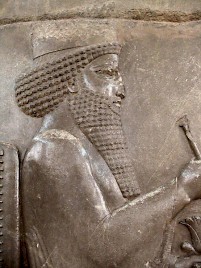Herodotus, bk 4, logos 11
Herodotus of Halicarnassus (c.480-c.429 BCE): Greek researcher, often called the world's first historian. In The Histories, he describes the expansion of the Achaemenid Empire under its kings Cyrus the Great, Cambyses, and Darius I the Great, culminating in Xerxes' expedition to Greece (480 BCE), which met with disaster in the naval engagement at Salamis and the battles at Plataea and Mycale. Herodotus' book also contains ethnographic descriptions of the peoples that the Persians have conquered, fairy tales, gossip, and legends.
Darius' campaign against the Scythians (4.83-144)

In the next logos, Herodotus deals with Darius' campaign against he Scythians. After crossing the Bosphorus by means of a large bridge, he subjects a tribe called Getes, on whose belief to be immortal Herodotus devotes a short digression.
Darius reaches the Danube, where the allied Ionian Greeks have already built a bridge. When the Persian army has crossed into what is now Romania, the king orders the bridge to be destroyed. A Ionian Greek in his army, Coes of Mytilene, objects to this and suggests not to cut off a possible line of retreat. The great king agrees and orders the Ionian Greeks to remain where they are for at least sixty days.
After a short digression on the Scythian tribes that Darius is about to engage, Herodotus tells about a Persian envoy who demands that the Scythians surrender. The nomads refuse and form three armies. Two of these lure the Persians deeper and deeper into Scythia, until they reach the river Oaros (the Volga). When Darius is finally able to join battle, he realizes that he can never win and follows Gobryas' advice to return to the Danube.
Meanwhile, the sixty days have passed and the Ionians deliberate what to do. The proposal of Histiaeus of Miletus to keep the bridge intact is finally accepted. Darius is able to return safely. He leaves Megabazus behind as governor of his European possessions.
Comment

This logos did not earn Herodotus his title Father of History. Even though the way the Scythians fight seems to be authentic, the narrative is messy and unintelligible. From the fact - if it is a fact! - that Darius wanted the bridge across the Danube to be destroyed, we may guess that he wanted to fight his way through Ukraine and across the Caucasus to Armenia; this hypothesis is as close as we can get to the historical truth.
The building of bridges across the Bosphorus and the Danube is a bit strange. It would have been easier and cheaper to use ships to transport the soldiers. However, it was forbidden for Zoroastrians to cross the sea, and it may be that this religious taboo necessitated the building of bridges.
This campaign must have taken place after 515 (when Darius conquered India and introduced gold coinage) and before 510 (when the Thracians are mentioned, in an inscription from Susa, as conquered nation). 514 or 513 are plausible; the latter is likelier.
The Oaros - the name usually indicates the Volga - reached by Darius may in fact have been the Dnepr (Borysthenes in Greek); the mistake can be explained from the presumed Scythian names of these rivers, *Varu(= Oaros, 'broad') and *Varu-stâna ('having a broad space').
There are some indications that the co-operation among the Scythians against the Persian invasion was an incentive to unite and form something resembling a real state.